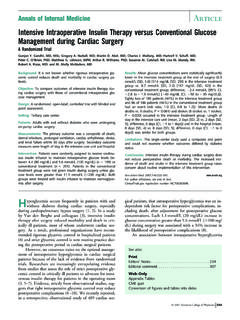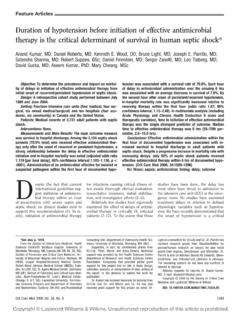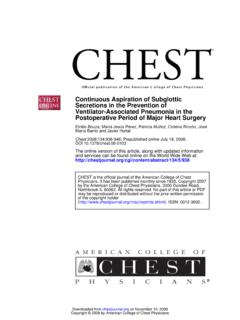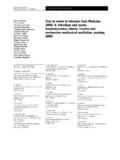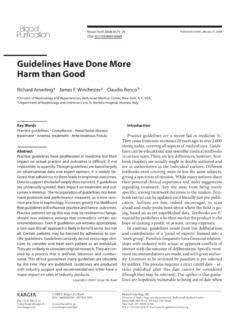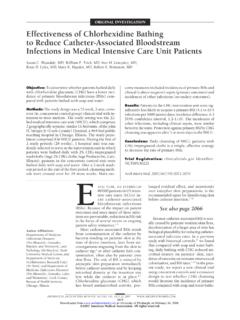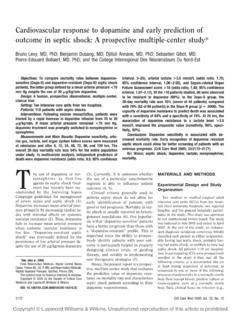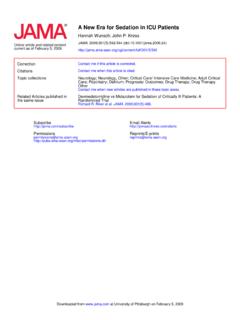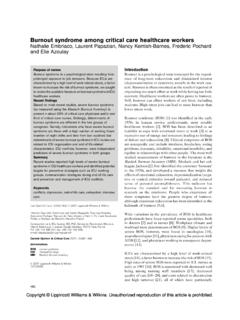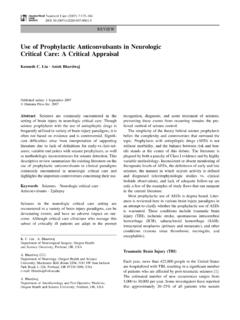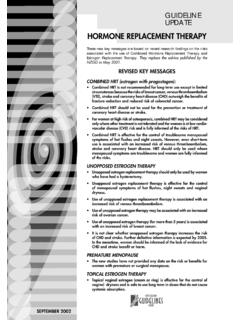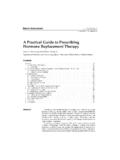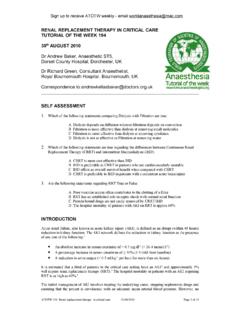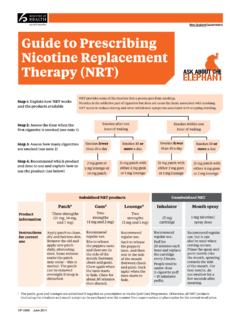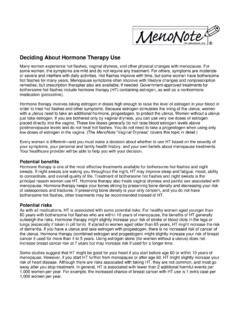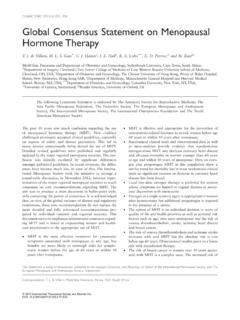Transcription of Antibiotic Dosing in Critically Ill Adult Patients ...
1 INVITED ARTICLE CLINICAL PRACTICE. Ellie J. C. Goldstein, Section Editor Antibiotic Dosing in Critically Ill Adult Patients receiving Continuous Renal replacement therapy Robin L. Trotman,1 John C. Williamson,1 D. Matthew Shoemaker,2 and William L. Salzer2. 1. Department of Internal Medicine, Section of Infectious Diseases, Wake Forest University Health Sciences, Winston-Salem, North Carolina;. and 2 Department of Internal Medicine, Division of Infectious Diseases, University of Missouri Health Science Center, Columbia, Missouri Continuous renal replacement therapy (CRRT) is now commonly used as a means of support for Critically ill Patients with renal failure. No recent comprehensive guidelines exist that provide Antibiotic Dosing recommendations for Adult Patients receiving CRRT.
2 Doses used in intermittent hemodialysis cannot be directly applied to these Patients , and Antibiotic phar- macokinetics are different than those in Patients with normal renal function. We reviewed the literature for studies involving the following antibiotics frequently used to treat Critically ill Adult Patients receiving CRRT: vancomycin, linezolid, daptomycin, meropenem, imipenem-cilastatin, nafcillin, ampicillin-sulbactam, piperacillin-tazobactam, ticarcillin clavulanic acid, cefa- zolin, cefotaxime, ceftriaxone, ceftazidime, cefepime, aztreonam, ciprofloxacin, levofloxacin, moxifloxacin, clindamycin, co- listin, amikacin, gentamicin, tobramycin, fluconazole, itraconazole, voriconazole, amphotericin B (deoxycholate and lipid formulations), and acyclovir.
3 We used these data, as well as clinical experience, to make recommendations for Antibiotic Dosing in Critically ill Patients receiving CRRT. Continuous renal replacement therapy (CRRT) is frequently mycin, meropenem, imipenem-cilastatin, nafcillin, ampicil- used to treat Critically ill Patients with acute renal failure or lin-sulbactam, piperacillin-tazobactam, ticarcillin clavulanic chronic renal failure. CRRT is better tolerated by hemodyn- acid, cefazolin, cefotaxime, ceftriaxone, ceftazidime, cefepime, amically unstable Patients and is as effective at removing solutes aztreonam, ciprofloxacin, levofloxacin, moxifloxacin, clin- during a 24 48-h period as a single session of conventional damycin, colistin, amikacin, gentamicin, tobramycin, flucon- hemodialysis [1].
4 Solute removal is particularly relevant to an- azole, itraconazole, voriconazole, amphotericin B (deoxycho- timicrobial therapy , because many Critically ill Patients with late and lipid formulations), and acyclovir. For drugs with no acute renal failure have serious infections and require treatment specific published data on Dosing in Patients receiving CRRT, with 1 antimicrobial. However, compared with data about we used known chemical properties and other clinical data Antibiotic Dosing in Patients undergoing intermittent hemo- ( , molecular weight, protein binding capacity, and removal dialysis, there is a relative paucity of published data about an- by intermittent hemodialysis) to make Dosing recommen- tibiotic Dosing during CRRT in Critically ill Patients .
5 In addi- dations. The pharmacokinetic and pharmacodynamic prop- tion, the rate of drug clearance during CRRT can be highly erties of each antimicrobial and the typical susceptibilities of variable in Critically ill Patients . relevant pathogens were considered (table 1). In most cases, We conducted a comprehensive review of Medline-refer- the recommended target drug concentration corresponds to enced literature to formulate Dosing recommendations for the the upper limit of the MIC range for susceptibility. The goal following antibiotics frequently used to treat Critically ill Adult of our Dosing recommendations is to keep the concentration Patients undergoing CRRT: vancomycin, linezolid, dapto- above the target MIC for an optimal proportion of the Dosing interval, reflecting known pharmacodynamic properties (time- Received 21 January 2005; accepted 19 June 2005; electronically published 12 September dependent vs.)
6 Concentration-dependent killing), while mini- 2005. Reprints or correspondence: Dr. Robin L. Trotman, Dept. of Internal Medicine, Section of mizing toxicity due to unnecessarily high concentrations. How- Infectious Diseases, Medical Center Blvd., Winston-Salem, NC 27157 ever, these recommendations are meant to serve only as a guide Clinical Infectious Diseases 2005; 41:1159 66. 2005 by the Infectious Diseases Society of America. All rights reserved. until more data are available, and they should not replace sound 1058-4838/2005/4108-0013$ clinical judgment. Recommended dosages are listed in table 2. CLINICAL PRACTICE CID 2005:41 (15 October) 1159. Table 1. Pharmacokinetic and pharmacodynamic parameters of drugs used for treatment of crit - ically ill Adult Patients receiving continuous renal replacement therapy .
7 Half-life Primary Volume of for normal Time-dependent Target PBC, route of distribution, renal or concentration- trough level, a b Drug % elimination L/kg function, h dependent killing mg/L. Acyclovir 15 Renal 2 4 Time NAc Ampicillin 28 Renal Time 8. Aztreonam 56 Renal Time 8. Cefepime 16 Renal Time 8. Cefotaxime 27 38 Renal 1 Time 8. Ceftazidime 21 Renal Time 8. Ceftriaxone 90 Hepatic 8 Time 8. Cilastatin 40 Renal 1 NA NA. Ciprofloxacin 40 Renal Concentration 1. Clavulanate 30 Hepatic 1 NA NA. Clindamycin 60 95 Hepatic 3 Time 2. Colistin 55 Renal 2 Concentration 4. Daptomycin 92 Renal 8 Concentration 4. Fluconazole 12 Renal 30 Time 8 16d Imipenem 20 Renal 1 Time 4. Itraconazole 99 Hepatic 10 21 Time Levofloxacin 24 38 Renal 7 8 Concentration 2.
8 Linezolid 31 Hepatic Time 4. Meropenem 2 Renal 1 Time 4. Moxifloxacin 50 Hepatic 12 Concentration 2. Piperacillin 16 Renal 1 Time 16. Tazobactam 20 23 Renal 1 NA 4. Ticarcillin 45 65 Renal Time 16. Sulbactam 38 Renal 1 Time 1 4. Vancomycin 55 Renal 6 Time 10. Voriconazolee 58 Hepatic 12 Time NOTE. NA, not applicable; PBC, protein-binding capacity. a Data are for the parent compound. b Denotes the highest MIC in the susceptible range for applicable pathogens, such as the b-lactam MIC for Pseu- domonas aeruginosa. c Trough concentrations of acyclovir are not routinely measured because this agent is phosphorylated into the active form acyclovir triphosphate. d The higher level is the recommended target trough concentration for Candida species with an MIC in the dose- dependent, susceptible range (fluconazole MIC, 16 32 mg/mL; itraconazole MIC, mg/mL).
9 E The oral bioavailability of voriconazole is estimated to be 96%. DESCRIPTION AND NOMENCLATURE OF CRRT current dialysate flow, and drug removal depends on dialysate and blood flow rates. CVVHDF utilizes both diffusive and con- Several methods of CRRT exist, and there is inconsistency in vective solute transports and can require a large amount of the literature regarding nomenclature. For this review, we will fluid to replace losses during ultrafiltration [1 6]. use the following terms: continuous arteriovenous hemofiltra- The pharmacokinetics of drug removal in Critically ill pa- tion (CAVH), continuous venovenous hemofiltration (CVVH), continuous arteriovenous hemodialysis (CAVHD), continuous tients receiving CRRT is very complex, with multiple variables venovenous hemodialysis (CVVHD), and continuous venov- affecting clearance.
10 These variables make generalized Dosing enous hemodialfiltration (CVVHDF). These are consistent with recommendations difficult. Drug-protein complexes have a the definitions established by an international conference on larger molecular weight; therefore, antibiotics with low protein CRRT [2]. The most common modalities currently used in binding capacity in serum are removed by CRRT more readily. intensive care units are CVVH, CVVHD, and CVVHDF [3]. Similarly, antibiotics that penetrate and bind to tissues have a During CVVH, solute elimination is through convection, larger volume of distribution, reducing the quantity removed whereas CVVHD utilizes diffusion gradients through counter- during CRRT.
